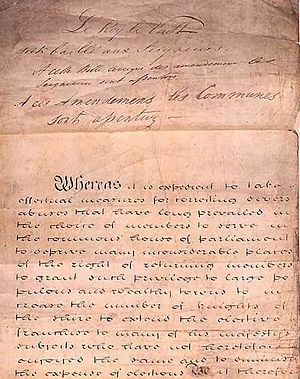La Reyne le veult facts for kids

When a new law is approved in the Parliament of the United Kingdom, a special phrase is used: "La Reyne le veult" (meaning "The Queen wills it") or "Le Roy le veult" ("The King wills it"). This phrase is in Norman French, an old form of French. It shows that the Monarch has given their official approval, called Royal Assent, to a new law or a private bill.
Contents
History of Royal Assent Language
The idea of the Monarch giving their approval to new laws started with William the Conqueror. This was to show that the King wanted something to become law. Over time, Norman French became the common language for educated people and in legal matters.
From French to English
For a long time, the Parliament of England did all its work in French. This continued until the late 1300s, during the reign of King Edward III. English was rarely used in Parliament before the 1400s, during the time of King Henry VI. While Royal Assent was sometimes given in English, it was more often in French. By 1488, Parliament stopped writing new laws in French or Latin. Since then, all new laws have been published in English.
Attempts to Change the Language
During the time of the Protectorate, when Oliver Cromwell and later his son Richard Cromwell governed England, Royal Assent was given in English. However, after the monarchy was brought back in 1660 (called the Restoration), the old practice of using Norman French was restarted. It has continued ever since.
There was one attempt to stop using French in Parliament in 1706. The House of Lords tried to pass a bill to get rid of French in all Parliament and court activities. But the House of Commons did not agree, so the bill failed. Even though French was later removed from courts in 1731, Parliament kept using it for Royal Assent.
How Royal Assent is Given
The Norman French phrase is used to show that the Monarch has officially approved a bill, making it a law. The Clerk of the Parliaments in the House of Lords is the person who says the phrase.
The Ceremony in Parliament
The process begins after the Lord Chancellor and the Lords Commissioners have read out the official document (called Letters patent) for the bill. Then, the Clerk of the Crown reads out the short title of the bill. After this, the Clerk of the Parliaments says the Norman French phrase 19 times. They say it towards the House of Commons at the bar of the House. The phrase is also written on the bill itself to show the Monarch's approval.
Sometimes, the wrong phrase has been used by mistake. A famous example is the Act of Supremacy 1558. For this important law, the phrase "Soit fait comme il est désiré" (meaning "Let it be done as desired") was used instead of "La Reyne le veult". "Soit fait comme il est désiré" is usually used for personal bills, not public ones.
When Assent is Not Given
If a Monarch were to refuse Royal Assent, the phrase "La Reyne / Le Roy s'avisera" would be used. This means "The Queen / The King will consider it." However, no British Monarch has refused Royal Assent since Queen Anne in 1707. That refusal was about a disagreement over the military in Scotland.
Images for kids
-
Start of the parchment roll of the Reform Act 1832, with the clerk's record of the royal assent of King William IV written above the bill, reading in full Le Roy le Veult soit baillé aux Seigneurs. A cette Bille avecque des amendemens les Seigneurs sont assentuz. A ces Amendemens les Communes sont assentuz.


